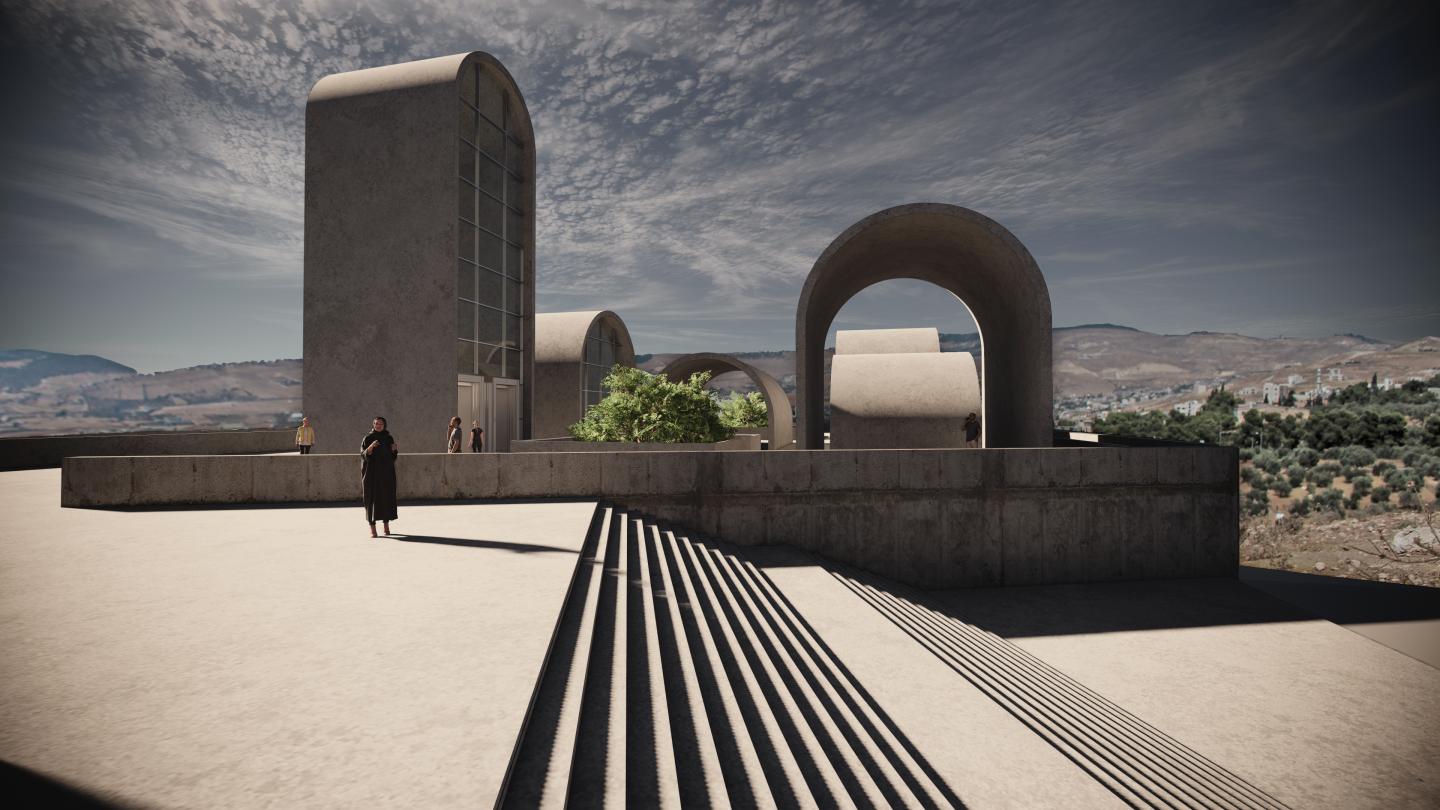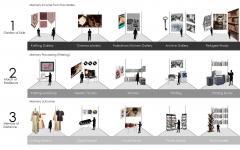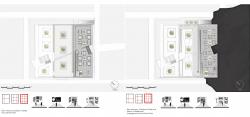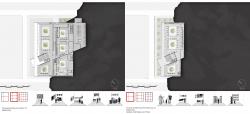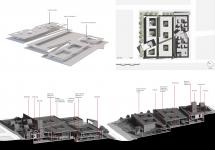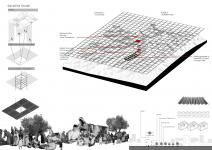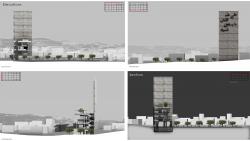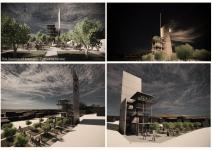Introduction
"Palestine," the promised land, for all the people who are now known as "refugees," the people who were forced to leave their own homeland and had no choice but to settle in neighboring countries, becoming "refugees."
Aim of the Project.
To respond to “The Zionist”, “The Deal of the century” (which seeks to invalidate the rights of the Palestinians to their land, to their history, and to their heritage) and “one of the late politicians Golda Meir” who said (Elder people die and the younger generation forgets).
The part of this response is to preserve Palestinian identity by collecting Palestinians' memories in refugee camps, transferring, storing, and documenting the memory, where the museum embraces the memories of the refugees among its walls.
Implementation
This priceless memory will be collected by creating an archive memory box (satellite nodes) that gathers the memories of refugees who witnessed Palestine's glory days in all refugee camps where stories are told by refugees, heard by people, and documented by the memory guardian (The Memory Tank Museum) that quarantines, stores, and documents Palestinian memories, stories, narrative, and traditions in one place. To ensure that their memories, collected from various camps in Jordan and the surrounding cities, are delivered to the world.
So, the project is divided into two parts:
1)The Source of the Memory (Satellite node)
Location: all Palestinian Refugee Camps in Jordan, Lebanon, Syria and Palestine.
(responsible to collect and transfer the memory to the “Memory Tank Museum” )
2) The Memory Tank Museum:
Location: Jordan, Balqa’a Governorate, Baqa’a
Lies 20 km north the Jordanian capital Amman, next to Sweileh.
Baqa’a camp lies 1.8 km from the site.
The location of the Memory Tank Museum was placed in front of the biggest Palestinian Refugee camp in Jordan and the second biggest in the middle east which is “Baqa’a Camp”. where the site also has a panoramic view of the camp, which is an important part of the experience in the museum.
(responsible to document and quarantine the memories coming from all the Palestinian refugee camps, where the visitors are also responsible to deliver the memory to the next generation)
Concept
The museum's concept was derived from the journey and emotions of Palestinians when they were first expelled from their own homeland and FRAGMENTED to the cities around them, settling in camps and becoming "refugees," but despite this segregation, they remained UNITED in preserving their heritage, traditions, affiliation, right of return, and memories.
These three stages followed a grid, which was derived from the grid of development of the refugee camps; they began with 3x4 asbestos sheets and zinco roofing, then 6x8 empty spaces, and 12x16 when concrete began to pour into the camps (the entire unit), and these three stages reflect the grid enlargement through the concept of fragmentation to unity.
From Fragmentation to Unity, From intangible to tangible memory, this divided the museum into three stages:
1)The Garden of Exile (Memory income) -grid 3x4-
Palestinian memories transferred from "The satellite node" are put in a room that preserves memory beneath the garden of exile and beneath each arc where their walls welcome memory in galleries and cinemas. To access the beneath memory after completing the garden of exile, you must pass through a ramp surrounded by a 15m wall height, giving you the sensation of penetrating the apartheid wall.
Going through the fractured memories of refugees will give you a sense of fragmentation as well, due to the way I divide up the spaces.
This space is divided into three areas, which are reflected by three courtyards that address Palestine Anthropology, the first courtyard "cultural anthropology," which is in charge of recording Palestinian stolen food and Palestinian knitting, and each city has its own composition.
The second courtyard is titled "Social Anthropology," and it discusses their heritage, beliefs and traditions.
The third courtyard is titled "Linguistic Anthropology," and it depicts the various accents of each region.
2) March of Resilience (Memory Processing) -grid 6x8-
By creating workshops that are only accessible to staff, the memory here begins to transform from intangible to tangible memory. The visitors begin their journey with a platform that overlooks the live processing memory. The concept of the three courtyards continues to the end of the project, and the first courtyard is in charge of documenting the memories through printing machines, with the final outcome of books, photos, and CDs about the memories of refugees. Where the end result is the photo and book market. The second courtyard is Embroidery machines this space is documenting through knitting and preserving the Palestinian compositions from different cities. Where the outcome is knitting market.
The third courtyard is responsible to document the Palestinian kitchen and the stolen food. Where the outcome of this space is food market and Palestinian kitchen.
3) Memory of Existence (Memory outcome) -grid 6x8-
The memory is absolutely tangible in this instance, as it is seen from a Palestinian restaurant and markets. Visitors can preserve their memories by purchasing items from the picture, book, knitting, and food markets, as well as discovering Palestinian cuisine in the restaurant and, most importantly, the theater with a view of the Baqa'a camp.
Visitors will know that all the memories they have seen in the previous stages are all coming from the refugee camps in this stage, which is the end of the journey, and only in this stage is the panoramic view available with a clear visual link.
At night, the satellite node will emit a visible beam of light to demonstrate the continuous transfer of memory to the Memory tank museum.
The three stages are separated by ramps that lead the visitor to the next stage, where the first ramp represents their "struggle" and the second represents their "reality."
The main Spine line axis
I realized that the baqa'a camp, with its orientation and grid structure, formed a very strong axis to the museum, which influenced my project and each stage in different ways:
The entrance was initially oriented parallel to the axis.
The skylight that illuminates the platform and workshops was oriented parallel to the axis in the second level.
The theater that overlooks the Baqa'a camp was oriented parallel to the axis in the third level.
The Source of the Memory (Satellite node)
I created a set of criteria for locating these satellite nodes in camps:
1)inside the camp
2)centralized (easy access)
3)on a flat land (making it easier on elderly)
4)exposed (next to the main street in the camp not in alleys)
5)between each satellite node 500 m (5-7mins walk)
6)area of the satellite node 150-200m
Memories can be found in every house and every corner, in every family gathering and ceremony, in the back of every old man and woman's head, and in the hearts of the young; however, for these stories to be harvested, they must be collected in one place.
The functions I assigned to the satellite node are focused on their backgrounds, where, how, and when Palestinians gather. So, the functions are a community kitchen and coffee place, celebrating forgotten and traditional stolen food prepared entirely by the hands of refugees, and bringing the past to the present through old stories buried in the hearts of Palestinian refugees.
Furthermore, the satellite node is the addition of the subtracted (courtyards) in the memory tank museum, which explains the concept of memory filling. In addition, two main elements were added at night: the light beam and the 20m written on the wall in the evening, which informs visitors about the source of this memory and its location. This wall also serves as a barrier for the stories and narrative. An outdoor area with orange trees between the seating areas adds a touch of the Palestinian symbol.
2020
2021
Area of the project :14 dunum
Structural system is used in the satellite node to reflect the temporality of the camps.
Concrete in the museum reflecting the rigidity and resilience of Palestinians memories.
The memory tank museum is flanked by a concrete wall that protects the entire memory transformation process; additionally, you can notice the glass separation distance following the grid of each stage, reflecting the concept of progressing to unity.
walkthrough link :https://www.youtube.com/watch?v=VPMbhnOhgFQ
Designed by : Raya Nazi
Supervisor : Arch. Thaer Qub'a
Favorited 2 times
